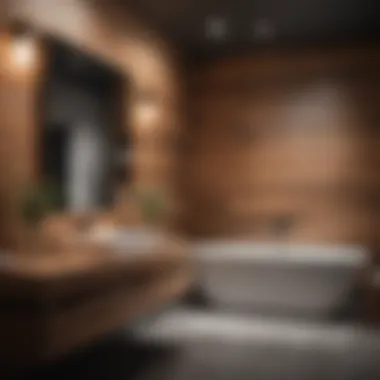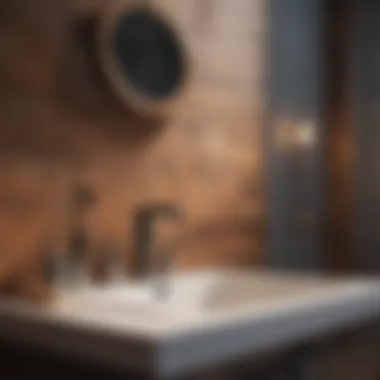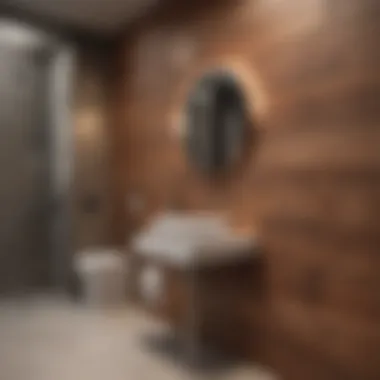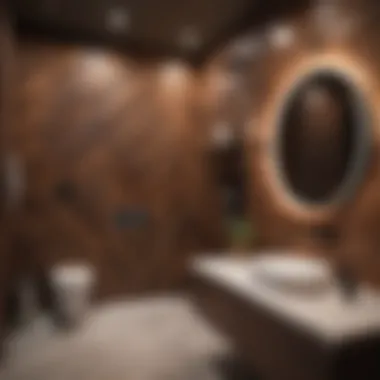Installing Paneling in the Bathroom: A Comprehensive Guide


Intro
Installing paneling in a bathroom can enhance aesthetics and functionality. Homeowners often seek both style and practicality when updating this essential space. This article offers a detailed approach to successfully installing paneling, considering material choices, installation techniques, and post-installation care. An understanding of trending designs can help inform choices, while practical tips can streamline the process and ensure long-lasting results.
Design Inspiration
Trending Styles
Choosing a style for your bathroom paneling is crucial. Contemporary designs favor clean lines and minimalism, often featuring materials like smooth wood or sleek plastic panels. On the other hand, a more rustic appeal may involve reclaimed wood paneling, which adds character and warmth. It's essential to consider how your chosen style complements existing decor and fixtures.
Here are some common styles to consider:
- Classic Beadboard: Timeless design that suits various aesthetics.
- Shiplap: Popular for creating an open and airy feel.
- Tongue and Groove: Offers a seamless look with versatility in textures.
Color Palettes
The colors you select can dramatically influence the ambiance of the bathroom. Neutral tones like white, gray, or beige typically provide a clean backdrop, allowing other elements to stand out. If you prefer bolder options, jewel tones can create striking focal points without overwhelming the space.
"The right color choice not only enhances the visual appeal but also impacts the perception of space."
Consider lighter shades for smaller bathrooms to create an illusion of space, while darker hues can add sophistication to larger areas. Experimenting with paint finishes, like matte or gloss, also plays a role in the overall feel of the paneling.
Practical Tips
Maintenance & Care
Once paneling is installed, maintaining its appearance and integrity requires some efforts. Regular cleaning is essential, especially in areas prone to moisture. A mild soap solution works well for most surfaces. Avoid abrasive cleaners as these can damage the finish.
Key maintenance tips include:
- Wipe down panels regularly with a soft cloth.
- Inspect for signs of damage or moisture.
- Reapply sealant if necessary.
Budgeting & Planning
Before starting the installation, set a realistic budget that accounts for both materials and labor. It’s helpful to gather quotes from local suppliers and consider both high-end and budget options. Planning involves measuring the area accurately to ensure a precise fit and minimize waste.
Steps for proper budgeting:
- Outline costs of materials.
- Estimate labor if hiring professionals.
- Account for unexpected expenses.
Following this guide will help ensure your paneling installation is not only aesthetically pleasing, but also efficient and durable.
Prolusion to Bathroom Paneling
Bathroom paneling is a significant topic for homeowners looking to enhance their spaces. It involves covering the interior walls with various materials that not only improve aesthetics but also add functionality. Understanding this process is crucial because the bathroom is a high-moisture environment that poses challenges to traditional wall treatments. Paneling can offer both protection and style, making it an attractive option for many.
The core purpose of bathroom paneling goes beyond mere decoration. It serves to create a barrier against humidity, thereby preventing long-term damage to the walls beneath. Furthermore, it allows for easy cleaning and maintenance, which is essential in spaces prone to splashes and spills. Paneling also represents an opportunity to express personal style, as it comes in various designs, colors, and materials. By choosing the right paneling, one can elevate the overall appeal of the bathroom.
In this section, we will delve into the definition of bathroom paneling and its fundamental purpose, helping readers to grasp why they should consider it for their homes.
Definition and Purpose
Bathroom paneling refers to the application of boards or sheets to the walls in a bathroom. These panels can be made from different materials such as wood, vinyl, or even tile. The main purpose of paneling is twofold: protection and enhancement of the bathroom's appearance.
Protection is a primary function. Paneling shields the underlying structure from moisture, reducing the risk of mold and mildew. It also provides a layer of insulation, helping to maintain temperature control. When selected correctly, the materials can endure the stresses of a humid environment without warping or degrading.


On the aesthetic side, paneling can dramatically change the look of a bathroom. It allows for a variety of styles, from rustic wood finishes to sleek modern vinyl. It provides an opportunity to add texture and color, making the space feel more inviting.
Benefits of Paneling in Bathrooms
The benefits of installing paneling in bathrooms are numerous. Some of the key advantages include:
- Moisture Resistance: Properly chosen paneling can resist water damage, which is vital in a high-humidity area like a bathroom.
- Easy Maintenance: Most paneling materials are easy to clean, requiring only a quick wipe-down to maintain their appearance. This is a significant benefit for busy households.
- Aesthetic Versatility: With various styles and finishes available, homeowners can customize the look of their bathrooms to reflect their personal tastes and design preferences.
- Increased Property Value: Well-executed paneling can enhance the overall value of a home. Prospective buyers often appreciate the added style and functional benefits.
- Thermal Insulation: Paneling contributes to better insulation. It can help retain warmth in cooler months, making the bathroom more comfortable.
"Paneling in bathrooms serves as both a functional shield against moisture and a transformative decor element."
In summary, bathroom paneling simplifies maintenance, enhances appearance, and offers effective moisture management. This makes it a practical choice for anyone looking to upgrade their space.
Choosing the Right Paneling Material
Selecting the appropriate paneling material is fundamental in achieving a successful bathroom transformation. It impacts not only the visual aesthetic but also the durability and practicality of the space. Different materials come with unique characteristics, benefits, and maintenance needs. Understanding these traits can help homeowners make informed choices that blend style with functionality. Key considerations include moisture resistance, ease of installation, and overall cost.
Wood Paneling
Wood paneling offers warmth and a classic allure, making it a popular choice. It presents various styles, from rustic to contemporary. However, it is crucial to choose wood that can resist moisture. Teak and cedar are good options. They naturally withstand humidity and prevent warping. Additionally, using proper seals and finishes enhances durability.
Homeowners should also consider the installation process. Wood paneling can be more labor-intensive when fitting. It might require specific tools and techniques to ensure a smooth application. Maintenance involves regular sealing and checking for damage. Keeping the wood clean and well-protected helps preserve its beauty.
Vinyl Paneling
Vinyl paneling is an excellent choice for budget-conscious individuals. It is lightweight, water-resistant, and comes in numerous designs and colors. Vinyl does not warp or rot, making it ideal for high-humidity areas like bathrooms. Furthermore, it is relatively easy to install. Many homeowners opt for peel-and-stick options, reducing the need for additional adhesives or fasteners.
However, it is essential to select high-quality vinyl paneling. Cheaper varieties may fade over time or become brittle. Maintenance involves simple cleaning routines, mostly just wiping with a damp cloth.
MDF Paneling
Medium-density fiberboard, known as MDF, is another economical alternative. MDF panels are smooth, which allows for versatile finishes and paints. They can mimic the look of wood without the high cost. MDF is easy to cut and shape, making it suitable for custom designs.
The downside is that MDF is not naturally water-resistant. Therefore, it's critical to apply a proper sealant before installation. Homeowners must be diligent in maintaining the panels to prevent moisture damage. Regular inspections and touch-ups might be necessary to keep MDF looking its best.
Stone and Tile Paneling
Stone and tile paneling exudes elegance and sophistication. It is inherently resistant to moisture, making it perfect for bathrooms. Options range from natural stone, such as granite or marble, to ceramic tiles. The variety ensures there is something for every taste. Moreover, they are incredibly durable and can last decades when properly installed.
Installation requires skilled hands, as precise cutting and placement are needed to avoid gaps. Grouting must be performed carefully to prevent water from seeping underneath. Maintenance includes periodic sealing and thorough cleaning to maintain their luster.
In summary, selecting the right material for bathroom paneling is crucial. Each choice carries its own set of advantages and disadvantages, necessitating a careful evaluation based on individual needs, preferences, and budget.
Tools and Materials Required
Choosing the right tools and materials is essential when installing paneling in your bathroom. The process demands not only a keen eye for detail but also a proper setup to ensure that the project runs smoothly and yields satisfactory results. Understanding the tools and materials helps avoid unnecessary complications during installation, contributing to both the quality of the work and the visual outcome of the paneling.
Essential Tools for Installation
When preparing for paneling installation, having the right tools can make a significant difference. Here are some tools you will need:
- Measuring Tape: Precision in measurements can save time and resources. You should measure the area where paneling will go carefully.
- Level: This tool ensures that your panels are not only straight but give a finished look.
- Utility Knife or Panel Saw: Depending on the material of the paneling, having a sharp utility knife or a panel saw is critical for cutting panels to fit.
- Nail Gun or Hammer: Fastening the panels securely is necessary. If you think there are many panels to install, a nail gun will save effort.
- Adhesive Applicator: For those using adhesive to install the panels, a proper applicator will guarantee even coverage.
- Caulking Gun: This tool is helpful for sealing edges and ensuring moisture does not penetrate.
- Safety Gear: Always protect yourself with safety glasses and gloves to handle tools securely.
Additional Materials Needed
In addition to tools, specific materials will be necessary. These materials directly influence how well the panels adhere and look after installation. Ensure you have:


- Paneling Material: Depending on the choice made earlier (wood, vinyl, MDF, or tile), you must have enough to cover your space.
- Adhesives: If you opt for adhesive installation, select one that is specifically designed for the material you are using.
- Nails or Screws: These fasteners will hold the panels in place. Choose ones that are suitable for your specific panel material.
- Caulk: This is used not just for filling gaps but also for moisture protection. A high-quality caulk meant for bathrooms is ideal.
- Paint or Finish (optional): If you plan to paint or finish the panels after installation, ensure those materials are suitable for humid environments.
By gathering these tools and materials beforehand, you can minimize delays during the installation phase. This organized approach not only enhances efficiency but also boosts your confidence as you work through the project.
"The success of paneling installation often hinges not on the panels themselves but on the preparation and tools at hand."
By being well-prepared, you can focus on the art of installation rather than scrambling for tools mid-project.
Preparing for Installation
Preparing for the installation of paneling is a key phase that can make or break the success of your project. This step involves careful consideration of the environment, measurements, and surface readiness. Without adequate preparation, misalignment or damage might occur, which leads to less than optimal results. Proper preparation ensures that the installation process flows smoothly, ultimately saving time and resources.
Assessing the Bathroom Environment
The first step in preparing for installation is assessing the bathroom environment. You should evaluate humidity levels, ventilation, and temperature. Bathrooms are typically moist, so it is essential to choose paneling that can withstand such conditions. For instance, vinyl paneling is a good option due to its moisture resistance, while wood might require additional treatment to prevent warping.
Furthermore, consider current wall conditions. Look for mold, mildew, or water damage, as these can compromise the integrity of the paneling. Addressing any underlying issues before installation is crucial for long-term success. This step not only protects the new paneling but also maintains the overall health of your bathroom's atmosphere.
Measuring and Planning Layout
Next, accurate measurements are vital. Use a tape measure to assess the height and width of the walls where paneling will go. Planning your layout in advance will also help in minimizing waste and ensuring that you have enough material.
Documentation is important in this phase. It is a good idea to draft a simple sketch showing where the panels will be placed. Consider factors such as the positioning of fixtures, doors, and windows. This sketch can guide the cutting and fitting of panels later on. A well-thought-out layout can elevate the aesthetics of the bathroom significantly.
Preparation of Surfaces
Finally, surface preparation cannot be overlooked. Clean the walls to remove dust and grease. If you find any holes or imperfections, fill them using a suitable filler, then sand the area smooth. It's also wise to apply a primer, especially if you are working with wood paneling. This serves as a sealer and ensures better adhesion for the paneling.
Surface preparation is a fundamental step that significantly impacts the ease and quality of the installation.
In summary, thorough preparation for paneling installation involves assessing the bathroom environment, measuring accurately, and ensuring surfaces are ready for new materials. These steps are not only practical, but they also pave the way for a more aesthetically pleasing bathroom once the panels are installed.
Installation Techniques
Installation techniques are crucial in achieving a successful bathroom paneling project. Proper techniques ensure not just the appearance but also the durability of the paneling. The process involves careful planning, precise execution, and considerations for factors specific to bathroom environments, such as humidity and water exposure. Using the right methods can greatly enhance the overall result and therefore the satisfaction of homeowners and design enthusiasts alike.
Dry-Fit the Panels
Before making any permanent adjustments, dry-fitting the panels is an essential step. This means placing the panels in their intended positions without permanently attaching them. The goal is to assess fit, alignment, and aesthetics without commitment.
During the dry-fit, check for various aspects:
- Spacing: Ensure even gaps between panels, if any, for consistent design.
- Dimensions: Confirm that each panel fits correctly within the walls and around fixtures.
- Visual Appeal: Assess how the materials interact with one another and with the existing décor.
Taking measurements again for each section is a wise practice. This step can prevent costly errors later and provide confidence that the installation will look just as envisioned.
Applying Adhesives or Fasteners
Once dry-fitting is complete and everything is in order, it’s time for applying adhesives or fasteners. The choice of method often depends on the material of the paneling. For instance, wood paneling may require screws, while vinyl can often rely on adhesive.
Key considerations include:
- Type of Adhesive: Ensure the adhesive is suited for high-moisture environments. Water-resistant options are necessary for bathrooms.
- Fastener Placement: If using screws, ensure they are positioned at strategic points for maximum support without compromising aesthetics.
- Application Technique: For adhesives, a thin, even layer is vital for proper bonding. Avoid excessive application to prevent overflow.
Following the manufacturer's guidelines for both adhesive and paneling material will yield the best outcome. Careful application promotes longevity and stability in paneling, vital due to bathroom conditions.


Seam Alignment and Finishing
Achieving perfect seam alignment is where skill meets precision. Aligning seams appropriately enhances the visual coherence of the paneling. Gaps or misalignments can detract from the overall look, emphasizing the need for meticulous care.
To ensure proper seam alignment:
- Layout Planning: Mark lines on the wall where the panels will go. This provides a visual guide during placement.
- Adjustments During Installation: Be ready to make slight adjustments as panels are being secured, especially in challenging areas.
Finishing touches are also important. After the panels are set:
- Caulking: Apply caulk at seams or around fixtures to create a more finished look and prevent moisture infiltration.
- Paint or Stain: If desired, apply paint or finish to enhance the appearance and add an extra layer of protection.
Proper seam alignment and finishing not only enhance the visual appeal but also protect the underlying layers from moisture damage.
Understanding and executing these installation techniques can transform any bathroom, lending it a cohesive and polished look. The effectiveness of paneling installation largely revolves around these pivotal steps, equally emphasizing both skill and careful planning.
Post-Installation Care and Maintenance
Proper care and maintenance after installing paneling in your bathroom is critical to ensuring that it remains functional and aesthetically pleasing. Without diligent upkeep, the benefits of your investment can diminish over time. This section will discuss three crucial aspects of post-installation care: cleaning paneling effectively, identifying damage and repairing it, and implementing preventative measures for longevity.
Cleaning Paneling Effectively
Regular cleaning is essential to maintain the visual appeal and hygiene of paneling in your bathroom. Different materials may require specific cleaning methods to avoid damage. For instance:
- Wood Paneling: Use a soft, damp cloth with mild soap. Avoid excess water to prevent warping.
- Vinyl Paneling: You can use a mixture of warm water and mild detergent. Rinse well and dry to avoid streaks.
- MDF Paneling: This can be wiped clean with a damp cloth. Ensure you do not soak it since moisture can lead to swelling.
- Stone and Tile Paneling: Use pH-balanced cleaners. Harsh chemicals may cause discoloration or damage.
It is best to clean these surfaces regularly to prevent the buildup of mold or mildew, which can thrive in humid environments like bathrooms. A consistent cleaning schedule will also make deep cleaning less daunting.
Identifying Damage and Repairing
After installation, it is essential to frequently inspect your paneling for signs of damage. Some common issues include:
- Water Damage: Look for discoloration or bubbles, particularly near plumbing fixtures.
- Cracks or Chips: These may occur due to humidity changes or impact.
- Mold Growth: This can develop in damp areas. If you spot it, act immediately.
Repairing damage promptly can save you from significant costs later. For minor scratches or chips in wood or MDF paneling, consider using a wood filler or a touch-up paint. For vinyl or tile, replacement of the damaged panel is often more effective. Regular inspections allow you to catch these issues before they worsen.
Preventative Measures for Longevity
Taking preventative steps can significantly extend the life of your bathroom paneling. Here are some key measures:
- Control Humidity: Use exhaust fans to reduce moisture buildup. This is essential in bathrooms where humidity levels can quickly rise.
- Sealant Application: For wooden paneling, a good quality sealant can protect against moisture and mildew. Ensure the application is reapplied every few years.
- Proper Ventilation: Ensure your bathroom has adequate airflow. This helps keep the space dry and can prevent the growth of mold.
Providing your bathroom paneling with proper care and maintenance is not just about aesthetics. It protects your investment and ensures longevity. Taking the time to clean, inspect, and implement preventative measures can make a significant difference in the life and look of your bathroom paneling.
"The secret to a long-lasting bathroom paneling lies in diligent care and timely repairs."
Regularly engaging with these tasks will create a beautiful and welcoming bathroom space.
Culmination
This section serves as a critical synthesis of the installation process of paneling in bathrooms. It brings together the essential elements discussed throughout the article and emphasizes the importance of understanding each step involved in the process. The goal is to enhance both the aesthetics and functionality of a bathroom space through effective paneling techniques.
Recap of Key Points
Throughout this guide, we’ve explored various aspects of bathroom paneling, highlighting the following key points:
- Types of Paneling Materials: Several materials like wood, vinyl, and MDF were covered, each with distinct advantages.
- Tools and Preparation: The necessity of having the right tools was emphasized. Preparing the bathroom environment is essential for a successful installation.
- Installation Techniques: How one can dry-fit panels and apply adhesives was detailed to ensure a smooth process.
- Post-Installation Care: Maintenance tips were provided to ensure the longevity of the paneling and to identify possible damage early.
The importance of these points cannot be understated as they collectively contribute to a durable and visually appealing bathroom finish.
Final Thoughts on Bathroom Paneling
As you consider this project, remember to take your time in each step and don’t rush the process. Whether you are a homeowner or an interior design enthusiast, understanding these elements allows for a more successful installation, ultimately leading to a space that feels both functional and stylish. Bathroom paneling should not just be seen as a decorative element, but as an integral part of home improvement that can add value to your property.















